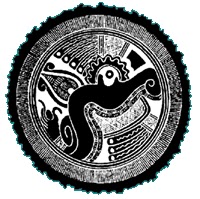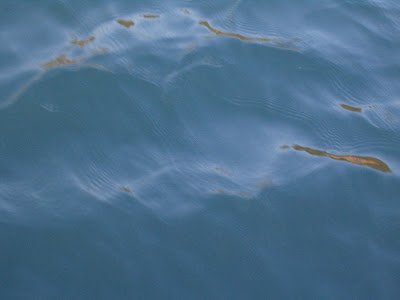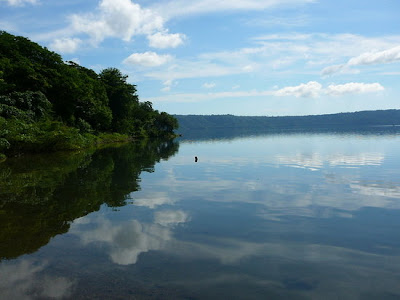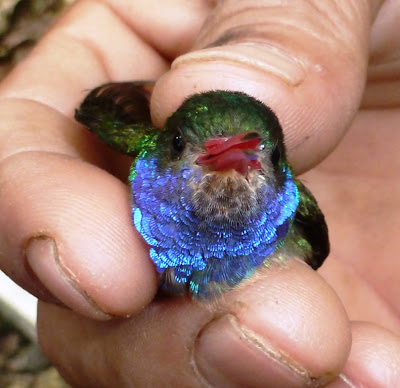 |
| Blue-throated Goldentail (Hylocharis eliciae) in Laguna de Apoyo Nature Reserve, Nicaragua. Photo by Wendy van Kooten. |
Identifying some birds in the forest on sight is relatively easy, especially when the birds are large. Among the most difficult birds to identify are the hummingbirds (Trochilidae). They are the smallest, of course. And, their feathers are iridescent. They glow brightly when the light is just so, but when the light is not just right, they may appear black. We love catching hummingbirds in our bird monitoring project, because we get to see the birds in brilliant splendor, which is immeasurable for the hummingbirds.
The
Blue-throated Goldentail is quite local in
Laguna de Apoyo Nature Reserve. They are absent from the forests close to
Estacion Biologica, yet they are common in a couple of our monitoring sites, one of them where we monitor with mist nets. We think they appreciate the added humidity of the sites where they are common, because the added shade there holds moisture better than in the more open areas.
 |
| This Blue-throated Goldentail (Hylocharis eliciae) is getting measured before getting released to resume his life in the wild. Photo by Wendy van Kooten. |
The Blue-throated Goldentail males form
leks, areas dense with males seeking breeding partners, in the dry season. These males don't look different from females, so their distinctive attributes are found in their voice and in their ability to defend a well-positioned perch near the center of the lek. The forest round them is filled with their calls as each competes with the others for the attention of female potential mates.
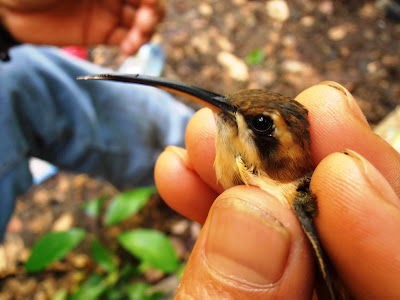 |
| The Stripe-throated Hermit (Phaethornis striigularis) in Laguna de Apoyo Nature Reserve, Nicaragua. Photo by Wendy van Kooten. |
Most hummingbirds are amply covered by shiny, metallic green plumage. The only hummingbird in Laguna de Apoyo Nature Reserve without any green feathers is the Stripe-throated Hermit (
Phaethornis striigularis). This bird may suggest a moth in flight. It tends to be found in low areas such as canyons, dark and humid areas, avoiding the sun.
Birdwatchers easily identify the Stripe-throated Hermit on site, in contrast to some of the other hummingbirds, thanks to its strongly decurved bill, as it is the only hummingbird in Laguna de Apoyo Nature Reserve with such a bill.
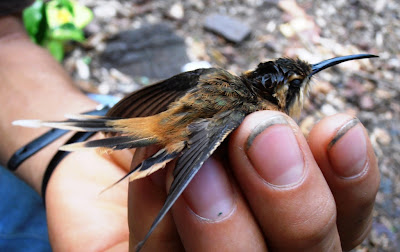 |
| The Stripe-throated Hermit shows off his tail feathers. His head has been moistened to facilitate age determination by examination of cranial ossification. Photo by Wendy van Kooten. |
The Stripe-headed Hermit was until recently, considered a subspecies of the Little Hermit (
Phaethornis longuemareus), which will be the reported name for our species in older records. The range for what is now considered the Little Hermit is restricted to east and south of eastern Venezuela.
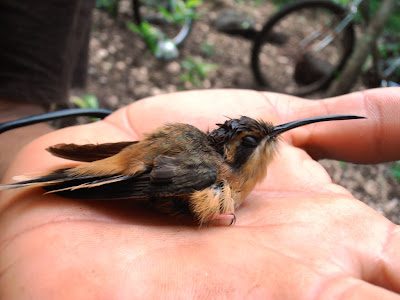 |
| The Stripe-headed Hermit (Phaethornis striigularis) is the only species in Laguna de Apoyo Nature Reserve sporting a strongly decurved bill. Photo by Wendy van Kooten. |
Our interns and volunteers at Estacion Biologica catch a few hummingbirds in every mist-netting activity. The hummingbirds require a slightly different treatment from other birds, because they are extremely small and fragile. At the slightest sign of weakness, we give a hummingbird water, by dabbing a drop onto the bill or submerging the bill into a capful of water. The bird may suffer easily from dehydration because of its extremely rapid metabolism and small size, so we must be observing it at all times to ensure it is strong and capable of returning to its normal routine when we release it. Hummingbirds, unlike some other bird species, don't tend to struggle when held by our technicians, and when we release them, they may sit for a few seconds before deciding to fly away.
 |
| The Steely-vented Hummingbird (Amazilia saucerrottei) is difficult to distinguish from the Blue-tailed Hummingbird (Amazilia cyanura) when observed at a distance. This bird was identified by the lack of rufous secondary feathers in the wing. Photo by Wendy van Kooten. |
Two nearly identical hummingbird species are found in
Laguna de Apoyo Nature Reserve: The Steely-vented Hummingbird,
Amazilia saucerrottei, and the Blue-tailed Hummingbird,
Amazilia cyanura. The Steely-vented Hummingbird, furthermore, has a disjunct range, with part in southwestern Nicaragua and northwestern Costa Rica, and another part in northern South America. As a result, the disjunct populations may very well qualify as different species, but more taxonomic study will need to be done on the birds throughout the range to make a conclusion.
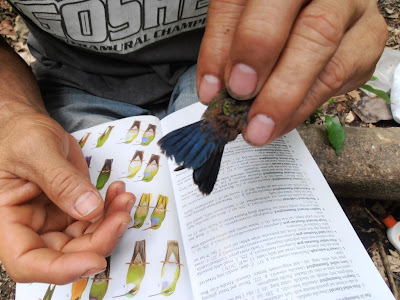 |
| The Blue-tailed Hummingbird has somewhat more rufous coloration than the Steely-vented Hummingbird. Both species are found in Laguna de Apoyo Nature Reserve. Here, our technicians comparing the bird with one of the field guides. Photo by Wendy van Kooten. |
We are catching both species in our mist netting studies. Our technicians must scrutinize each bird carefully, especially the secondary wing feathers to determine species.
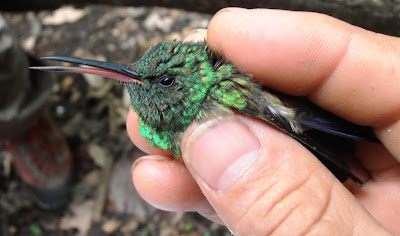 |
| Blue-tailed Hummingbird (Amazilia cyanura) in Laguna de Apoyo Nature Reserve, Nicaragua. Photo by Wendy van Kooten. |
Holding these small, delicate creatures is an unforgettable experience. Their legs are much too short to hold in the traditional photographer's grip. The holder invariably feels a concern for harming the bird in the hand, but with experience, one can learn how to manipulate a hummingbird carefully and effectively, getting all the information we seek from it and then releasing it to return to its normal life without harm.
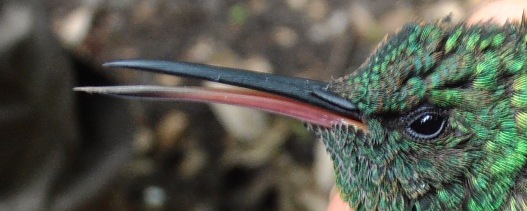 |
| Hummingbird feathers have a unique iridescence which make the birds especially attractive. Photo by Wendy van Kooten. |
Several of the hummingbird species found in Laguna de Apoyo Nature Reserve are members of the genus
Amazilia. These birds are medium to large size, with plumages similar between males and females. These birds don't only drink nectar for their sustenance-they consume a large quantity of tiny arthropods which they catch on the wing: spiders, midges, mosquitoes, most of which escape our view, but not that of the hummingbird. The consumed animals provide protein not found in most nectars.
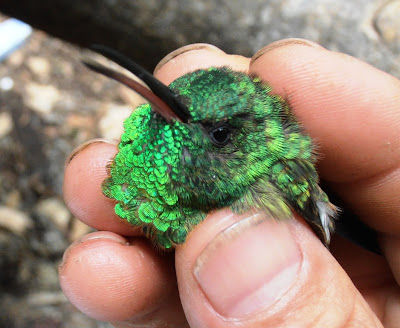 |
| The Blue-tailed Hummingbird glistens in sunlight. Photo by Wendy van Kooten. |
Our bird studies are performed by students performing internships and volunteers. No prior experience is necessary, only a long-term commitment to undergo training and collaborate with our team for several months. The rewards of having the opportunity to hold and handle many hummingbirds and other species of birds, to gather information about them to promote the protection of these birds and their habitats, is a lifetime of golden memories of the experience.
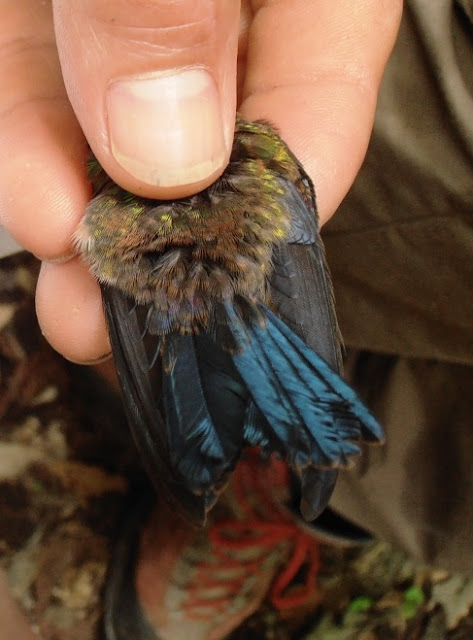 |
| Rusty coloration on the rump feathers is evident on the Blue-tailed Hummingbird (Amazilia cyanura). Photo by Wendy van Kooten. |
We have learned a few things about the hummingbirds of Laguna de Apoyo Nature Reserve, but there is more to learn here. For instance, what are the most important associations between plants and each hummingbird species?
How do different species share resources for feeding and nesting? Are any species restricted to certain parts of the Laguna de Apoyo Nature Reserve?
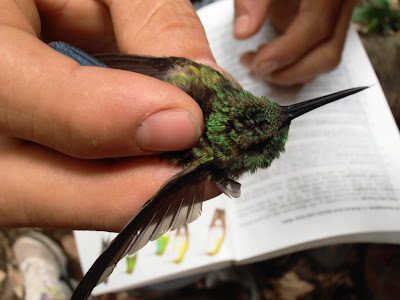 |
| Rufous secondary feathers can be seen on this Blue-tailed Hummingbird (Amazilia cyanura), captured in Laguna de Apoyo Nature Reserve. Photo by Wendy van Kooten. |
We never tire of seeing hummingbirds, so we are at the right place, because there are plenty of them here. Nonetheless, we are concerned for them, because Laguna de Apoyo Nature Reserve is facing constant threats to the habitats for wildlife such as hummingbirds. Firewood cutting, forest fires, and agriculture are all common activities. Foreigners have recently "found" Laguna de Apoyo as a great place to build a vacation home, too, and some people have cleared land to build more housing inside the Apoyo volcanic crater. How do these activities affect our hummingbirds?
 |
| From this angle, rufous secondary plumage can be seen in both wings on this Blue-tailed Hummingbird (Amazilia cyanura). Photo by Wendy van Kooten. |
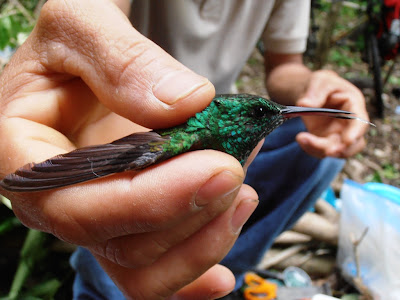 |
| The male Canivet's Emerald (Chlorostilbon canivetti) is the greenest of the hummingbirds in Laguna de Apoyo Nature Reserve. |
A common hummingbird throughout Laguna de Apoyo Nature Reserve is Canivet's Emerald,
Chlorostilbon canivetii. The male and female both tend to wag their tails forward and backward under their bodies while hovering around flowers or plucking tiny spiders from webs. The brilliant green especially of the male make its name seem so appropriate.
 |
| Male Canivet's Emerald is inspected after trapping during our mist net study in Laguna de Apoyo Nature Reserve, Nicaragua. Photo by Wendy van Kooten. |
Canivet's Emerald is found in all the areas of the reserve, including in yards, as long as there are flowers and some shade nearby. One can often find them flying very close, as they apparently have less fear of people than other hummingbirds in the area. It is not uncommon to get a very close view of one moving close to inspect the colors of one's clothing.
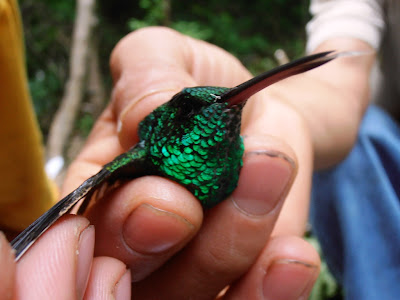 |
| A male Canivet's Emerald (Chlorostilbon canivetii) in the hand. Photo by Wendy van Kooten. |
The Canivet's Emerald makes a cup nest, only a few centimeters in diameter, from spider webs and very small bits of vegetation, often close to the ground on a low bush. They are susceptible to domesticated cats, as a result, and their populations in Laguna de Apoyo Nature Reserve may be suppressed because of the large number of cats owned by foreigners inside the reserve boundaries.
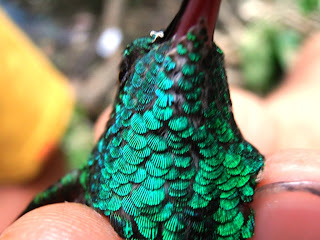 |
| The brilliant iridescence of the male Canivet's Emerald is especially strong in the hand. Photo by Wendy van Kooten. |
Now that we at
FUNDECI/GAIA have learned some things about the hummingbirds in Laguna de Apoyo Nature Reserve, we would like to pose some more subtle questions. How do we go about protecting the hummingbirds of our area? What are their needs and what can we do to make their populations in the wild more secure against the encroachment of man?
 |
| The Cinnamon Hummingbird (Amazilia rutila) is very common in Laguna de Apoyo Nature Reserve, Nicaragua. Photo by Wendy van Kooten. |
The most common hummingbird, particularly in fragmented areas such as around houses and agricultural plots, is the Cinnamon Hummingbird (
Amazilia rutila). It is larger than the other hummingbirds seen in our area. Its rufous throat, breast and tail set it apart from all the others, making it easily identified. This species is also found in green spaces in Managua and other urban centers, and it occupies a wide range of habitats.
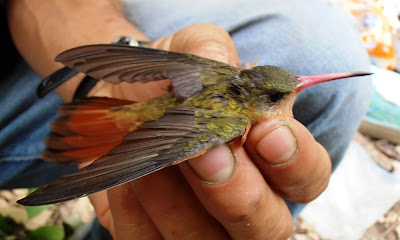 |
| The Cinnamon Hummingbird is larger than other hummingbirds in Laguna de Apoyo Nature Reserve. Photo by Wendy van Kooten. |
The Cinnamon Hummingbird has a surprisingly wide bill, possibly an adaptation to increase its capacity to capture flying insects on the wing. This versatile bird is the hummingbird most people know from their own yards.
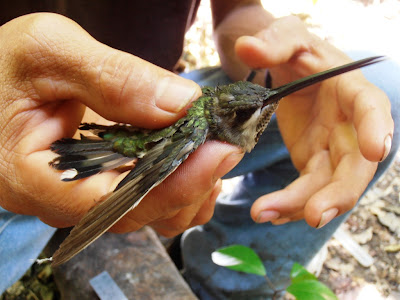 |
| The Plain-capped Starthroat (Heliomaster constantii) is nearly as large as the CInnamon Hummingbird, but its white breast ahd tail feathers, malar streak, and very long bill distinguish it easily. Photo by Wendy van Kooten. |
Hummingbirds are obviously specialists for drinking flower nectar. Within the hummingbirds can be found several more refined specialist forms. The Plain-capped Starthroat (
Heliomaster constantii), for instance, sports a much longer bill than any other hummingbird in Laguna de Apoyo Nature Reserve, obviously adapted for reaching nectar in certain flowers which would be unavailable for others. Its role in pollenation must be important for certain plants in our area, and we would like to make further investigations into this topic.
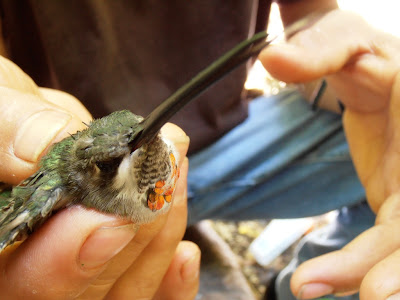 |
| This young Plain-capped Starthroat already has several metallic reddish feathers on its gorget. Photo by Wendy van Kooten. |
The Plain-capped Starthroat is the only resident bird of our area with a reddish throat, although the migratory Ruby-throated Hummingbird (
Archilochus colubris) males also have brightly colored gorgets. Interestingly, most of the Ruby-throated Hummingbirds found in our area are not adult males.
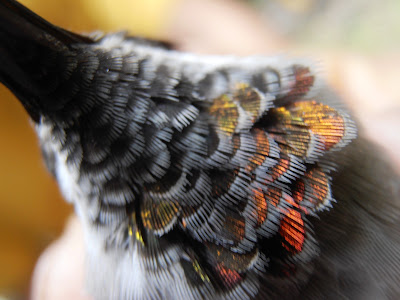 |
| The metallic colors on the gorget feathers of the Plain-capped Starthroat vary from gold to red. Photo by Wendy van Kooten. |
The Plain-capped Starthroat is found in dry habitats from Arizona into western Costa Rica. They are found throughout the Pacific region of Nicaragua.
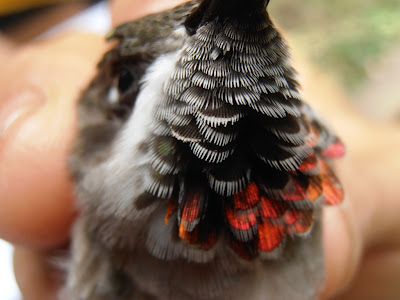 |
| Bright colors show on the gorget of this young Plain-capped Starthroat. Photo by Wendy van Kooten. |
Would you like to help us study the hummingbirds of Laguna de Apoyo Nature Reserve? If you would like to learn about hummingbirds, or if you would like to spend a day of "hummingbird tourism", we are happy to work with you. If you can not volunteer for a period, visit and make a day trip to see our bird studies in action, go birdwatching with us, or consider making a donation to our project. Please contact us!
